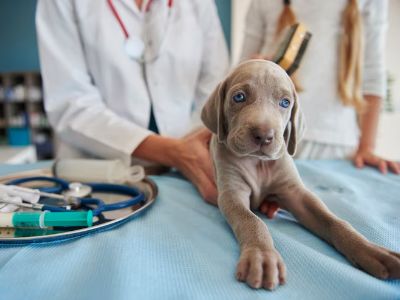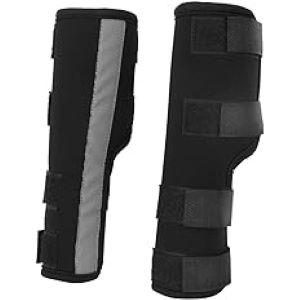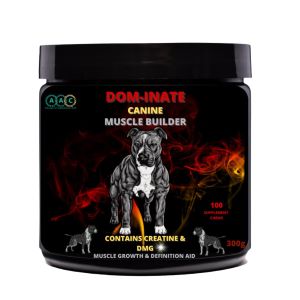Muscle wastage in dogs is a serious and devastating condition in dogs. Their life is compromised as they lose mobility and strength. It can happen to any dog, regardless of their breed, age, or lifestyle. The condition is also known as muscle atrophy and it can happen because of ageing factors, inactivity, illness, or injury.
But, how will you recognise the issue, and is there anything you can do about it? Well, if you have these concerns then keep reading! The article will provide you with the answers and you will get to about the types, diagnosis, treatment, and prevention of this condition in dogs.
You Might Also Like:
Muscle Wastage in Dogs
In general, muscle wastage or muscle atrophy is not a specific disease but, a term which describes the loss of muscle mass and function in our furry friends. There are many types of muscle wastage in dogs.
But, before we get into the details of each type, it’s crucial to understand what causes muscle wastage in dogs. Along with that, the functioning of the dog’s muscles and symptoms as well.
What causes muscle atrophy in dogs?
The general explanation of muscle wastage in dogs is the loss of muscle mass and function in dogs. This can happen to any muscle in a canine’s body but, normally is found more in the legs, especially the hind legs. But, how?
Well, dog muscles are made of a bunch of fibres that contract and relax in response to nerve signals from the spinal cord and brain. Their muscles require oxygen, hormones, and nutrients to function properly while maintaining their mass and strength.
Now, when there is a disruption in the normal functioning of the muscles, nerves, or blood supply, it results in muscle wastage. Below are some of the major causes responsible for dog muscle wastage:
- Genetics
Many dogs are prone to muscle wastage because of their genetic predisposition, genetic mutation, and defects. Great Dane myopathy, Labrador retriever myopathy, or fibrotic myopathy are some examples of genetic predispositions causing muscle wastage in dogs.
- Injury
An injury can cause trauma to the nerves or muscles and this can trigger inflammation, cause scarring and reduce muscle activity in dogs. Instances like bites falls, car accidents, burns, and surgery can cause muscle wastage.
- Disease or illness
There are some diseases or illnesses which can impact nerves or muscles directly. Parasites, metabolic disorders, cancer, or toxins can lead to muscle wastage issues. Neurological disorders are more likely to cause muscle atrophy in comparison to other issues.
- Ageing or inactivity
As dogs age, their muscles naturally lose mass and strength because of continuous wear and tear. They also experience hormonal changes and less activity during their senior age. Some dogs even suffer from arthritis and obesity, and are usually resting for their entire day. As a result, they suffer from muscle atrophy.
Symptoms for dog muscle wastage
We observed the causes resulting in muscle wastage in our furry friends, now, let’s have a peek at the symptoms of muscle wastage issues in dogs to get a better understanding and how you can recognise it.
- Weight loss – when your dog is losing weight, there is a definite prospect that they are losing muscle mass. You will easily notice this change as you pick up your dog. They will feel lighter than usual.
- Thinner muscles – these are easy to spot. You can touch and feel the areas where you observe thin or saggy muscles in your furry friend. While touching their body parts, you will feel they are much lighter. You must check the back legs first if your dog is prone to arthritis.
- Lethargy – your dog will feel lethargic as they are losing muscle mass and will have a tough time moving around. This is one of the major symptoms and says to recognise.
- Body posture – the loss of muscle mass will often cause their posture to change. You will see them limp on their leg, cross their legs, drag their paws or sag back.
- Weakness – losing muscle mass will definitely make your dog weak, especially if the loss is in a specific area.
Types Of Muscle Atrophy in Dogs

The causes, symptoms, and location of muscle loss are different in each dog, and there are different types of muscle atrophy in dogs. Here are they:
- Disuse atrophy
This type of muscle wastage occurs when the dog is not using their muscle limb for longer periods of time. The underlying cause is pain, less exercise, or surgery. A dog suffering from arthritis will avoid putting weight on their legs because of the severe joint pain. If the underlying causes are treated properly, this atrophy is reversible and dogs can resume normal activity.
- Neurogenic atrophy
Degeneration or nerve damage in dogs can cause such atrophy, the communication between the muscles and nerves is affected and a dog might sustain injury, breakdown of muscle tissue, or paralysis.
The affected muscles lose nerve supply and become flabby and weak. Neurogenic atrophy is fatal and irreversible. The treatment for this atrophy is only possible if the nerve damage is not extensive.
- Myopathy
This atrophy occurs when there is damage in the muscle tissue itself. There is an infection, trauma, metabolic disorder, inflammation, or genetic defects in the tissue causing muscle wastage. The affected muscles in myopathy are swollen, painful, necrotic, or stiff.
Further, myopathy in dogs can be both chronic and acute. In fact, in this type, more than one muscle is affected at once.
Treatment For Atrophy in Dogs

The treatment for atrophy/muscle wastage in canines will rely on the causes, the severity of the symptoms and the type of atrophy the dog is suffering from. But, before we have a look at the treatment options, let’s see how the vet will conduct a diagnosis:
- History of dog
The vet will thoroughly inquire with the dog owner regarding the dog’s age, breed, diet, medical history, and signs and symptoms that you noticed before taking them to the clinic for treatment. This will help them recognise the potential issue and how extensive the atrophy issue is.
- Examine the dog’s physical condition
A vet will conduct an extensive examination of the dog’s physical health condition. They will check their muscle tone, joint function, mobility, and muscle mass. In addition, they will also try and identify signs of inflammation, injury, or infection.
Further, the dog’s body weight and body condition score will also be analysed. The vet may also palpate your furry friend’s muscles and feel for any bony deposits, swelling or atrophy.
After this examination, you may see the vet perform the following diagnostic tests:
- Blood test – helps in detecting abnormalities in dogs’ blood cells, hormones, chemistry, or immune system.
- Urine tests – provide details of the dog’s urine function or composition. It also helps in diagnosing inflammation, infections, or other metabolic disorders.
- CT scans or MRIs – the images of a dog’s soft tissues are analysed for identifying nerve damage, identify tumours, or degeneration issues. The dog’s brain and spinal cord are also evaluated.
- Biopsies – help in getting a sample of a dog’s muscle tissue for microscopic examination and look for any signs of damage, cancer, infection, or genetic defects in the dog. A biopsy helps diagnose myositis ossificans, myopathies, muscle tumours, or metabolic disorders.
- X-rays – are beneficial in visualising a dog’s bones, and joints, and looking for dislocation, fracture, arthritis, bony deposits, or deformities.
- Genetic testing – this method recognises any variations or mutations in correlation with the muscles in their DNA. In addition, this testing can also reveal degenerative myelopathy, (SOD1A variant), Great Dane myopathy (BIN1 variant), Labrador retriever myopathy (PTPLA variant), or other genetic disorders.
- Electromyography – gauges the electrical activity of a dog’s nerves and muscles. The test will show whether there is damage, dysfunction, or degeneration. This test also helps in the diagnosis of neuromuscular damage, genetic disorders, or degenerative myelopathy.
So, below are some of the basic treatments exercised for treating dog muscle wastage issues by vets:
#1. Medications
After a thorough diagnosis, the vet will prescribe the medications or supplements that will help resolve muscle wastage issues in dogs. They will suggest medications such as antibiotics, steroids, anti-inflammatories, L-carnitine, or painkillers.
In addition, you will also receive specific instructions regarding the dosage and the frequency of using the medicines or supplements. Your furry friend will constantly get assessed, and a vet will see how they respond to the medications. Based on the response to the treatment, they might alter the medications or supplements.
#2. Physical therapy
Once a vet analyses the muscle condition, mobility, and joint function via a physical exam or some other test. A specific physical program is tailored based on the symptoms and physical condition of the dog. So, you can expect the following methods to be used on dogs:
- Stretching
- Manual therapy
- Massage
- Swimming
- Joint manipulation
- Therapeutic exercises
Normally, a vet would recommend you take your dog to a professional physical therapist for better results. Here also, based on how the dog responds to the therapy, a vet or the therapist might alter their therapy program.
#3. Diet and exercise
Analysing the body condition score, physical exam, metabolic rate tests and other tests of dogs, a vet will outline a balanced diet for improving their muscle condition. You must follow every instruction, and provide them with the food ingredients with their regular diet.
With the changes in diet, the vet will also suggest changing their exercises and their schedule as per the diet. The exercise will help in maintaining their muscle tone and improve their condition. After a week or so, the vet will check the condition of their muscles and get an insight into the tolerance of the exercise and how the dog responded to the diet changes.
#4. Surgery
Sometimes the results of different tests reveal some underlying tumour, or severe nerve damage and surgery is the only way to help the dog. The vet will explain the potential risks to the dog owner before proceeding with the surgery.
The surgery will mainly involve repairing nerve damage, removing tumours, correcting joint deformity, or removing bony deposits. In addition, post-surgery care will involve continuous monitoring and other medications for better recovery. Some vets also suggest aquatic therapy to facilitate restoration of the muscle mass and functioning.
Preventive measures to avoid dog muscle wastage
After observing the treatments and analysing how extensive surgery is, it’s obvious for you to think about how to prevent muscle wastage in dogs. Here are a few tips you can consider:
- Make sure your dog is getting regular exercise and physical therapy. It helps in stimulating the muscle fibres and boosts the blood flow which ultimately facilitates the repair and growth of the muscles.
- Adjust the dog’s diet to ensure its weight remains normal. Make sure they are getting quality food as it prevents obesity-related issues. So, if their weight is maintained, the strain on the muscles and joints is less and chances of degeneration or muscle wastage are significantly reduced.
- Train your dog to walk with stability and confidence. This will ensure that they will not fall, slip, or injure themselves while walking and hence, there is no injury, pain, swelling, or instability which can cause muscle wastage.
- You should use a harness or sling to help the dog maintain their level of mobility. They help in reducing stress on the weak or injured muscles and also stimulate muscle fibres. So, the dog’s muscle wastage is contained.
- Cover your dog’s paw with shoes, or socks, or use stick-on-pad protectors to safeguard their paws. These items help in avoiding injury, bleeding, infections or inflammation issues in their muscles. In addition, they are comfy for dogs and provide proper traction while walking.
- Use high-quality protein sources like eggs, fish, or meat in their meals. The amino acids in these ingredients can help with muscle repair and growth.
These are some of the preventive measures that you can consider to maintain the proper muscle health of your furry friend. Still, these methods can not address major issues like arthritis, degeneration, or any other infection that causes muscle wastage. In such a situation, you’ll have to consult with the vet and get their insights for proper recovery.
FAQs
What dog breeds are prone to muscle wastage?
German Shepherd Dogs, Pembroke Welsh Corgis, Rhodesian Ridgebacks, Chesapeake Bay Retrievers, Bernese Mountain Dogs, Great Danes, Labrador Retrievers, and Boxers are some of the dog breeds that are prone to muscle wastage. The common reason for such a vulnerability is genetics, metabolism, and environmental factors.
How will I know if my dog is suffering from muscle wastage issues?
To identify whether there is muscle wastage in your dog, you need to observe them closely look for changes in their weight, size, and shape, and feel the firmness of the muscles. In addition, you also need to have a closer look at their feet while they are walking. If you see them limping, or dragging their paws or legs, there is a definite chance of muscle wastage issue.
Which food items to avoid for dogs having muscle atrophy?
For dogs suffering from muscle atrophy, you must avoid feeding food items that are low in protein, or high in fats and carbohydrates. In addition, food items which may have allergens, excessive salt or sugar, or are toxic for dogs must not be given. So, don’t feed them processed meat, baked goods, fatty cuts of meat, candies or chocolate, onion, macadamia nuts or gum.
How much does it cost to treat atrophy in dog muscles in the UK?
On the basis of the cause, severity and type of the treatment the cost of treating atrophy in dog muscles in the UK will vary. This is because there are plenty of tests conducted before proceeding with the treatment. For instance, the diagnosis will include blood tests (£40-£120), urine tests (£25-£50), ultrasound (£200-£400), X-rays (£100-£300), muscle biopsy (£200-500) and etc. The total range for diagnosis itself is about £20-500+. Likewise, medications will cost between (£10-50+), physical therapy session may cost £20-£50 per session, and surgery cost ranges from £500 to £5000 and more.
Final Remarks
Muscle wastage in dogs is a condition where a canine loses their strength, they lose their mobility, gets weak, and their quality of life is also compromised. There are many underlying reasons and causes that trigger this issue. A dog can have muscle atrophy if they are injured, ill, have a genetic disorder, nerve damage or inflammation in muscle tissues.
The condition proceeds gradually and can affect any body part. The treatment for this condition will rely on how serious the issue is. The vet will pick the course of action based on the tests and proceed accordingly.
Muscle wastage issues are common and challenging but, not a deadly condition. With proper diagnosis and vet treatment, it’s manageable. The dog might not live the same old life but, can overcome the atrophy issue and live the rest of its life properly.






